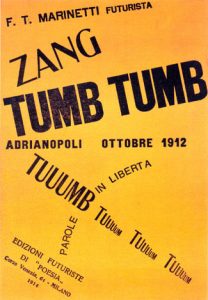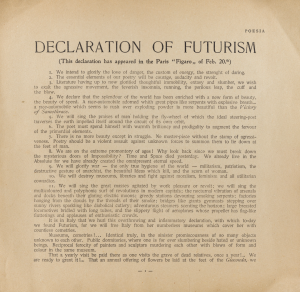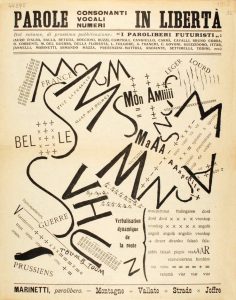Filippo Tommaso Marinetti, in full Filippo Tommaso Emilio Marinetti, Italian-French prose writer, novelist, poet, and dramatist, the ideological founder of Futurism, an early 20th-century literary, artistic, and political movement.

Image source: https://en.wikipedia.org/wiki/Zang_Tumb_Tumb
Marinetti was the founder of the Futurist movement, and between 1907 and 1908 he was associated with the utopian and Symbolist artistic and literary community of the Abbaye de Créteil. Marinetti is known as the author of the first Futurist Manifesto, written and published in 1909, and also of the Fascist Manifesto.
Childhood and education
Emilio Angelo Carlo Marinetti spent the first years of his life in Alexandria, Egypt, where his father (Enrico Marinetti, a Piedmontese lawyer) and his mother (Amalia Grolli, daughter of a Milan literature professor) lived together. They had come to Egypt in 1865, at the invitation of Khedive Isma’il Pasha, as legal advisers to foreign companies taking part in his modernization program.

Image source: https://en.wikipedia.org/wiki/Manifesto_of_Futurism
His mother was an avid poetry reader and introduced Marinetti to Italian and European classics, who developed a love for literature in his school years. He studied first in Egypt, then in Paris, obtaining a baccalauréat degree in 1894 at the Sorbonne, and in Italy, graduating in law at the University of Pavia in 1899, subsequently embarking on a literary career.
Futurist Manifesto

Image source: https://en.wikipedia.org/wiki/Manifesto_of_Futurism
Futurism had its official beginning with the publication of Marinetti’s “Manifeste de Futurisme” in the Parisian newspaper Le Figaro (February 20, 1909). His ideas were soon adopted in Italy, where the writers Aldo Palazzeschi, Corrado Govoni, and Ardengo Soffici were among his most important disciples.
Marinetti’s manifesto was also approved by the Futurist painters, who published their manifesto in 1910. Painters and sculptors such as Umberto Boccioni, Giacomo Balla, and Gino Severini realized Marinetti’s ideas.
What is Futurism?

Image source: https://en.wikipedia.org/wiki/Zang_Tumb_Tumb
The idea of Futurism was to break away from 19th-century Romanticism and eliminate the past by embracing speed and the modern industrial revolution in all aspects of life, including art, music, architecture, poetry, fashion, films, physics, and technology. Not surprisingly, its chosen symbols were the plane, the cinema, and the telephone, and, above all, the automobile. Futurism quickly spread to Germany, Russia, and the Americas. It rivaled Cubism in its influence on other 20th-century art movements including Art Deco, Surrealism, and Dadaism.
Marinetti and Fascism
Marinetti agitated for Italian involvement in World War I, and once Italy was engaged, promptly volunteered for service. In the fall of 1915 he and several other Futurists who were members of the Lombard Volunteer Cyclists were stationed at Lake Garda, in Trentino province, high in the mountains along the Italo-Austrian border. They endured several weeks of fighting in harsh conditions before the cyclist’s units, deemed inappropriate for mountain warfare, were disbanded.

Marinetti spent most of 1916 supporting Italy’s war effort with speeches, journalism, and theatrical work then returned to military service as a regular army officer in 1917. In May of that year, he was seriously wounded while serving with an artillery battalion on the Isonzo front; he returned to service after a long recovery and participated in the decisive Italian victory at Vittorio Veneto in October 1918.
Info sources: https://www.theflorentine.net/ https://en.wikipedia.org/wiki/Filippo_Tommaso_Marinetti https://www.theartpostblog.com/ https://www.britannica.com/biography/Filippo-Tommaso-Marinetti
